Thurmond is a storied town located along the New River in Fayette County, West Virginia. It was once the hub of local operations for the Chesapeake & Ohio Railway and the center of commerce.
History
A post office at then-called Arbuckle 4 opened in 1888 and was incorporated in 1900 as Thurmond, named for Confederate Captain William Dabney Thurmond. 8 17 Thurmond moved to the area in 1844 and after he had surveyed land in Fayette County, 2 he was offered 73 acres of land along the river as payment in lieu of $20. 17
Thurmond was situated along the proposed alignment of the C&O’s sea-to-river alignment between Newport News, Virginia, and Huntington, West Virginia. 4 8 The C&O was completed through the area in 1873. Owing to its isolated location, just one house was built in Thurmond, 8 and it was not until Thomas G. McKell of Glen Jean who had negotiated with the C&O for a branch up Dunloup Creek in 1892 that Thurmond became a boomtown. 7 8 Completed to Glen Jean in 1893, the C&O Loup Creek branch served 26 mines and was one of the C&O’s busiest spurs in the New River region. 4
A 70-foot turntable was constructed in Thurmond but was quickly made obsolete and replaced with a 100-foot turntable. 17
Thurmond became the center of local commerce. A passenger depot, freight station, engine house, turntable, water tank, coal, and sand towers were constructed, along with the Dunglen hotel, the Armour Meat Company meat-packing plant, banks, restaurants, stores, and boarding houses. The surge was so great that during the first two decades of the 20th century, Thurmond handled more freight than Richmond, Virginia, and Cincinnati, Ohio combined 2 5 and over 150 people worked for the railroad as laborers, brakemen, and dispatchers, with 18 train crews operating out of Thurmond. 8 There 26 mines were shipping freight directly in and out of the town, which included goods destined for the company stores and equipment for the mines up and down the New River and its tributaries. 19 Additionally, at its peak, nearly 95,000 passengers traveled through the depot each year. 3
The town was a dry community, which led McKell to build a small unincorporated village across the New River. McKell opened the 100-room Dun Glen Hotel in 1901, 8 17 19 which became infamous for hosting the world’s longest-lasting poker game at 14 years long.
Captain Thurmond did his best to thwart the plans of McKell by incorporating Thurmond in 1901 and passing an anti-liquor ordnance. 19 He had intended to enforce the ordnance to the Dun Glen Hotel. Not to be outdone, the boundaries of Glen Jean, which served as the center of McKell’s growing real estate, coal, and timber empire, was extended seven miles up Dunloup Creek to include the Dun Glen Hotel. Glen Jean had no anti-liquor ordnance.
By 1910, Thurmond was producing $4.8 million of freight revenue for the C&O, or 20% of the entire company’s revenue. 8 Its figure was ten times more than Richmond and 2½ times more than Cincinnati.
Prohibition was passed in 1914, curtailing much of the “boom town” rhetoric and effectively ending the “red light” district that was McKell’s community. In 1922, a large fire destroyed parts of Thurmond, 4 and in 1930, the Dun Glen Hotel burned. 4 8 Business waned by the 1930s as the Great Depression overtook the country. 2 The Thurmond National Bank closed in 1931, and the New River Bank, owned by the McKell family, moved to Oak Hill in 1935. 8 The Armor Meat Company and a telephone district office closed their doors in 1932 and 1938, respectively. 4 8
Thurmond saw a small revival during World War II when coal was in high demand that helped fuel the war effort, but the advent of the diesel locomotive led to an even greater change. No longer was coal and water replenishment needed for the massive steam engines and the required stops in Thurmond. The C&O was one of the last railroads to convert from steam-powered engines to diesel, and when it did, Thurmond’s railroad shops closed.
The population decreased from 462 in 1930 to 339 in 1940 and to 39 by 1990.
In 1978, the National Park Service established the New River Gorge National River to conserve and interpret the outstanding natural, scenic, and historical values of the New River Gorge, and to preserve the New River as a free-flowing waterway. 13 A General Management Plan, adopted in 1982, identified Thurmond as a prime historical site, and in 1984 the Thurmond Historic District was listed on the National Register of Historic Places. 16
In 1985, the Chessie System, the successor to the C&O, agreed to sell the derelict depot to the National Park Service. 18 Extensive work began in 1988 to develop a Development Concept Plan for Thurmond, and property acquisitions ramped up in 1989 when much of the old stock in the town was acquired. 16 After three years of negotiations, the Thurmond depot was purchased from CSX Transportation, the successor to Chessie, in July 1991 for $50,000. 15
In 1992, the National Park Service developed a $35 million plan to establish Thurmond into a tourist site, 12 which would have included purchasing the land and abandoned railroad property from CSX and restoring the old C&O depot and engine house. The three brick commercial buildings would also be restored.
The depot required the pouring of a new foundation, the construction of an elevator, and the erection of new sheer walls to provide lateral strength. 13 The wooden foundation had substantially deteriorated due to improper drainage, and the structure was severely leaning towards the railroad tracks. The work, awarded to Swope Construction of Bluefield, West Virginia, lasted from February 1994 to May 1995 and was finished at the cost of $2.5 million. 12 An additional $500,000 was spent on a retaining wall near the depot and on a sewage plant. 12 Nearly $1.3 million was allocated for the stabilization of the commercial buildings in the center of Thurmond.
The engine house was destroyed by a suspicious fire on August 21, 1993. 14 The post office closed in 1995. 10 In mid-1999, the water tower, once used as background in the “Matewan” movie, was razed over concern of its potential collapse. CSX refused to sell most of its remaining property and buildings, citing safety concerns.
Today, Thurmond has just five residents.
Buildings
Armour Meatpacking Plant
The Armour Meatpacking plant was in operation from 1905 to 1932 11/1937. 8 The structure housed the meat processing and refrigeration area on the first level and apartments for employees on the second level. 11 The building burned in 1963. 9
C&O Coaling Tower and Sand House
The C&O’s coaling tower and the sand house was designed by Fairbanks, Morse, and Company of Chicago and was constructed in 1922 of reinforced concrete. 11 A New York construction firm employed 25 to build the structure at the cost of $85,000. The C&O retained use of its steam locomotives more than any other major railroad operator, and the coaling tower and sand house were abandoned in 1960.


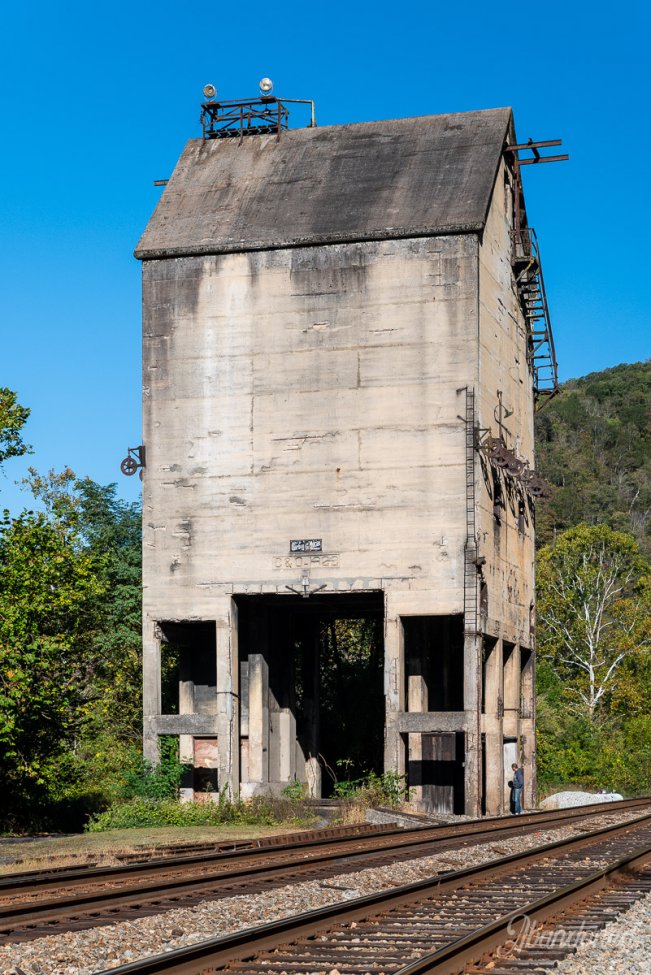



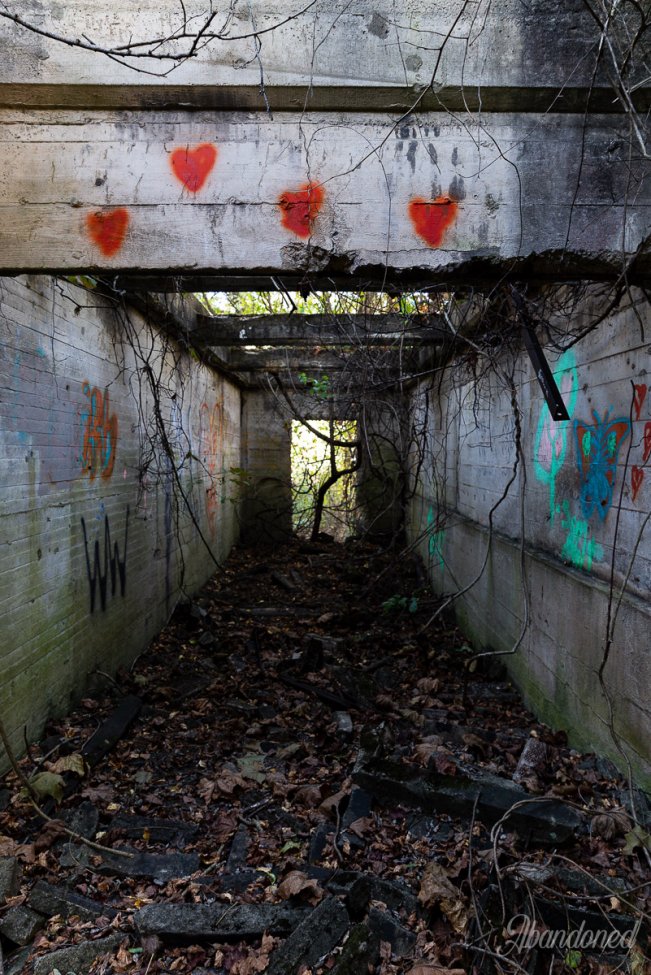
C&O Engine House
The C&O engine house and shop was constructed in 1905 and at its peak, the facility employed 175 mechanists, pipefitters, boilermakers, electricians, and blacksmiths to service and maintain two engines at once. 11 A crew office at the eastern end was where train crews were selected to deliver empty coal cars or pick up new, loaded ones. The engine house was enlarged to 245-feet 14 in 1921 to service up to four engines at one time and was in operation until the mid-1980s. The building burned on August 21, 1993.
Dun Glen Hotel
The Dun Glen Hotel was constructed in 1900 on the south side of the New River and was a large 4½-story wood-framed building with a wrap-around first-floor veranda. It housed not only 100 rooms, but an ice plant, barbershop, laundry, post office, and bar. 11 The hotel burned in 1930 under suspicious circumstances.
First Baptist Church




James Humphrey Jr. House
The James Humphrey Jr. House was constructed around 1920 and it is believed that this was the train master’s house. It was later owned by James Humphrey Jr., the mayor of Thurmond.




John Bullock / Roger Armandtrout House
Also known as Fatty Lipcomb’s, this structure was constructed around 1900 and was used historically as a boarding house. It was owned by the Littlepage family who lived on the first level and rented the second and then as a hostelry for whitewater rafters. It was filmed in the 1986 movie “Matewan.”




LaFayette Hotel
A frame structure hotel with 25 rooms was completed in 1891, 17 and was replaced with the 3-story, 35-room Lafayette Hotel in 1901. 8 11 The hotel was originally named the Thurmond, and then the LaFayette. The structure burned in 1963. 9
Goodman-Kincaid Building
The Goodman-Kincaid Building is a three-story structure, constructed in 1905 8/1906 11 with two stores and two floors of apartments. 8 The Standard Dry Goods Company purchased the lot and added the stone facade in 1907. 9 It was built as two separate sections which shared a common front. Standard operated out of the building until 1918.
The second floor hosted Dr. C.F. Ridge’s office and the telephone exchange. 8 9 Residents lived in the building until 1959 until the roof started to collapse. 9
In a 2002 assessment of the building’s integrity, the roof and flooring systems were noted as having failed with interior elements exposed. 11



Mankin-Cox Building
The Mankin-Cox Building is a three-story structure, constructed by Dr. J.W. Mankin in 1904 with two stores and two floors of apartments. 8 11 Mankin, who paid $4,000 for the 150-by-40-foot lot, 9 had offices on the second floor for the Mankin Drug Company, while his wife, a pharmacist, operated a drug store in the right-most storefront. The New River Banking and Trust Company moved from the Dun Glen Hotel in 1911 and occupied the other half of the first floor. The second floor also hosted Dr. Young, the town dentist.
The New River Banking and Trust Company relocated to the National Bank of Thurmond Building until it relocated to Oak Hill on September 21, 1935. 17
The Cox Building Company took over the structure in the 1920s. 8




National Bank of Thurmond Building
The National Bank of Thurmond Building is a four-story structure, and was host to the National Bank of Thurmond and storefronts on the first level and apartments above. 8 It was constructed in 1917 by the Bullock Realty Company and housed a jewelry company until 1922. 9 The National Bank of Thurmond acquired the building for $24,000 and immediately began renovations. The first level was initially cast-iron storefronts, but the bank remodeled their half into a limestone classical revival facade.
The National Bank of Thurmond closed in 1931. 8 A clothing store later operated out of the bank space, and residents lived in the building until 1959. 9 In 1975, the building owners connected it to an adjoining building and formed The Bankers Club, a hotel and restaurant that closed in 1988.



Post Office/Commissary
D.D. Fitzgerald constructed the Commissary in 1929 under an agreement with the C&O. 11 Fitzgerald owned the building and leased the property from the railroad. After the Lafayette Hotel was destroyed by fire in 1963, taking with it the post office, the commissary was converted into the town’s post office. It was closed in 1995. 10


Thurmond Station
The Thurmond C&O Station was constructed in 1888 and is a two-story wood-framed structure. 8 Captain Thurmond donated the land upon which it was built upon in 1887. 11 The original depot burned in 1903 and was replaced a year later, and enlarged by 15 feet on its eastern front in 1914. Inside, the two-story building housed not only a passenger depot but clerk’s offices, a trainmaster’s office, yardmaster’s office, car distributor’s office, and telegrapher’s cabin.
The Thurmond depot was rehabilitated in 1995 11 and is still in use today as an Amtrak station and visitors center for the New River Gorge National River.







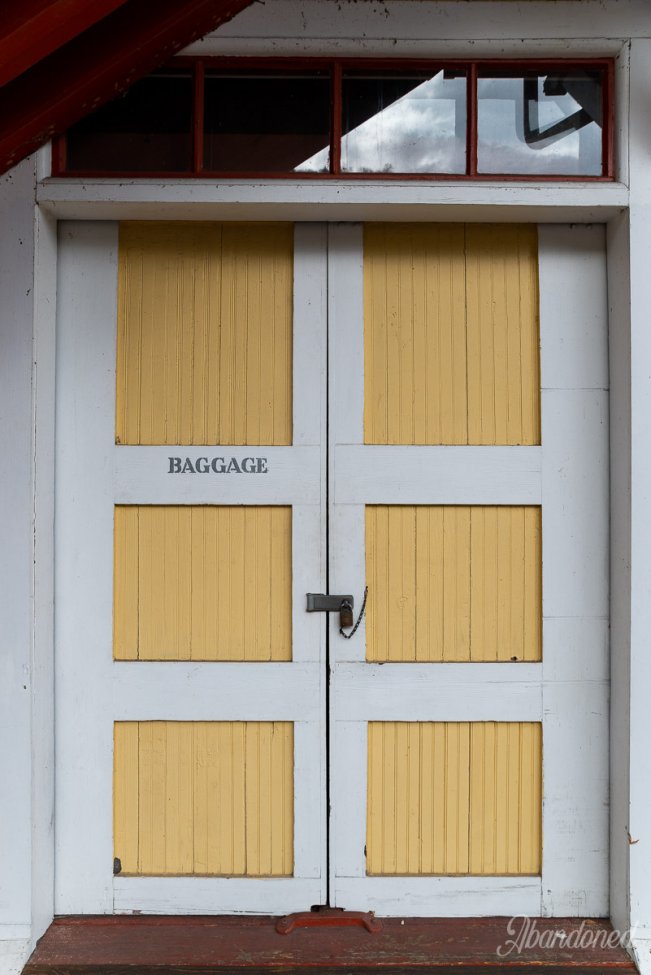


Thurmond Union Church
The Thurmond Union Church was constructed c. 1927 which replaced an earlier structure. It supported Baptist, Methodist, and Presbyterian congregations.



Other























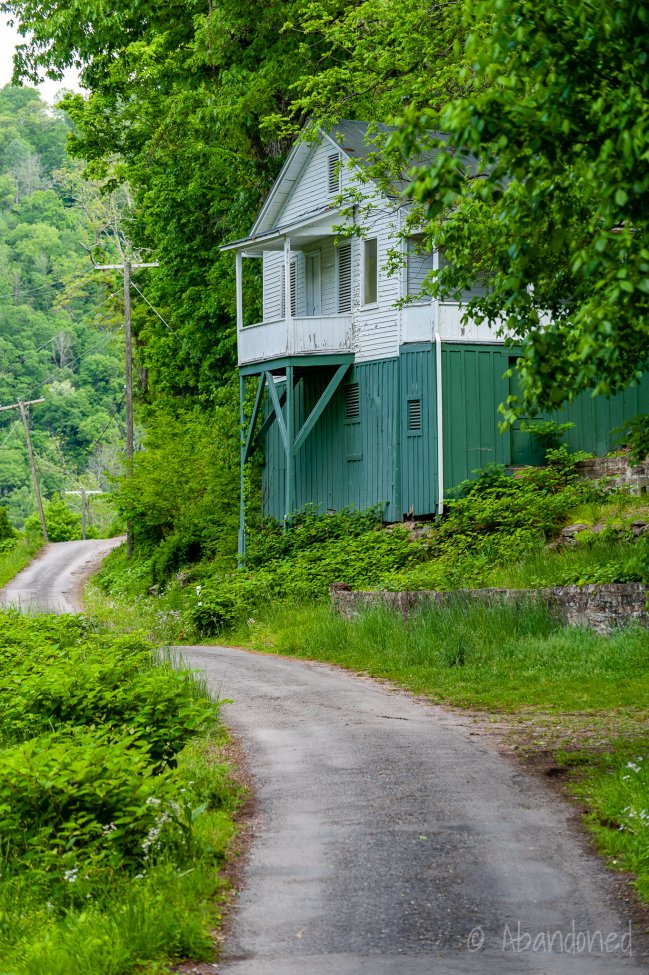










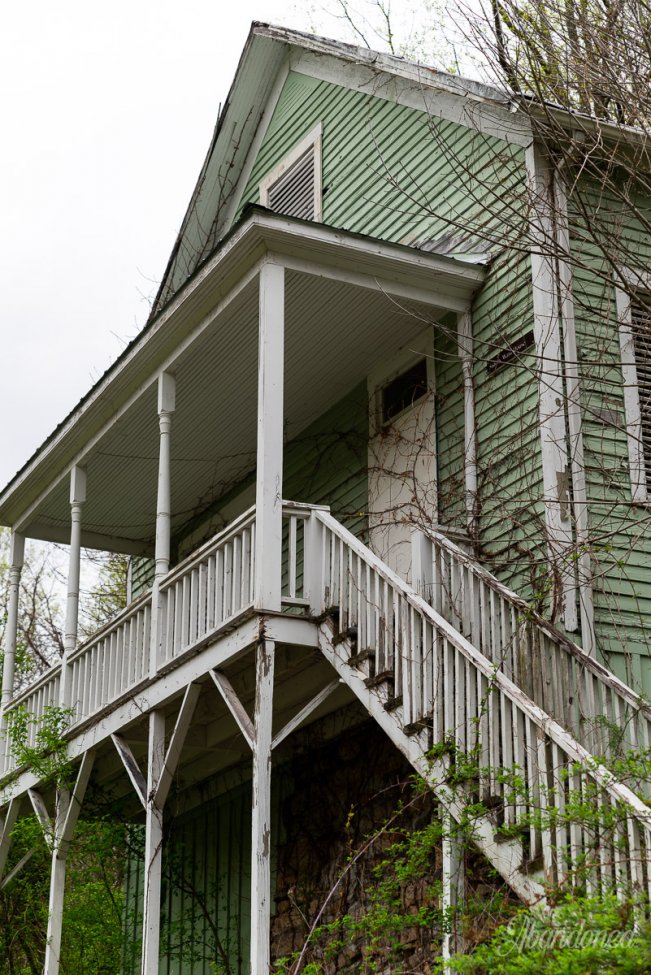

Share
Sources
- Census 2000 Information
- “Thurmond, WV.” National Park Service, Feb. 25, 2004. March 14, 2007 Article.
- “Thurmond.” National Park Service, Oct. 17, 2006. March 14, 2007 Article.
- Fair, Jessica M. “Thurmond: The Rise and Fall of a Coal City.” West Virginia Historical Society Quarterly 14.3 (June 2000). West Virginia Division of Culture and History. 14 Mar. 2007 Article.
- Shirley Donnelly. “Historical Notes on Fayette County, W. VA.” Oak Hill: Privately Printed, 1958.
- Melody Bragg, “Thurmond and Ghost Towns of the New River Gorge.” Glen Jean, GEM Publications, 1995.
- Knight, Wallace E. “Dunglen Hotel was Waldork of the Mountains.” Charleston Gazette. N.p., 4 May. 1952. Web. 8 June 2008. Article.
- United States. Dept. of the Interior. Thurmond Historic District. Comp. R. Eugene Harper. Washington: National Park Service, Sept. 1983. West Virginia Division of Culture and History. Web. 8 June 2008. Article.
- Interpretative signage.
- Helbock, Richard W. United States Post Offices, The Mid-Atlantic. Vol. 4. Scappoose, OR: La Posta, 2004. 242. Print.
- United States. Dept. of the Interior.” Thurmond Historic Structures Assessment, New River Gorge National River, West Virginia. Lowell, MA: National Park Service. June 2002. Print. 10 June 2013.
- Crouch, Matt. “Thurmond Plans Scaled Back.” Daily Mail [Charleston] 15 Mar. 2000: n.p. Print.
- Phillips, Greg. “The Thurmond Depot Restoration.” Chesapeake and Ohio Historical Magazine Mar. 1995: 6-10. Print.
- Hoyle, Steve. “Thurmond Enginehouse Burns Down.” Register Herald [Beckley] 23 Aug. 1993: n.p. Print.
- Hoyle, Steve and Ray Saunders. “National Park Service to Develop Thurmond.” Register Herald [Beckley] 17 Mar. 1992: n.p. Print.
- Hoyle, Steve. “Park Service to Acquire Thurmond Depot.” Register Herald [Beckley] 18 May 1990: n.p. Print.
- Ernest, Dale S. “Thurmond, West Virginia.” Chesapeake and Ohio Historical Magazine June 1988. 3-23. Print.
- “Park to Buy Thurmond Depot.” Charleston Gazette 4 Oct. 1985: n.p. Print.
- Bragg, Melody. “Thurmond.” Window to the Past. Glen Jean, GEM Publications, 1990. pp. 1-6.





9 Comments
Add Yours →[…] Interestingly, furnishings and floorings for the new building came from the Thurmond Lodge in Thurmond, while brick, roofing materials, and slate came from the old McKendree […]
[…] than at its heart? Not far from our campsite along the north rim of the New River Gorge was Thurmond, a storied town located along the New River that was once the hub of local operations for the […]
[…] the winding road to Thurmond was unplowed but easy to drive. The old-and-reliable Dunloup Creek Falls was as pretty as ever […]
[…] out near Fayetteville, West Virginia, and captured New River Gorge National Park and Preserve, Thurmond, the Glade Creek Grist Mill at Babcock State Park, and various other […]
[…] fourth on the entire C&O system in total revenue receipts. In 1910, the C&O operation at Thurmond had grown to being first in revenue receipts at $4.8 million representing about 20% of the entire company’s revenue. Thurmond was responsible for more […]
[…] down in Thurmond, the near-daily fog events have given the storied town an almost spooky, otherworldly appearance […]
I enjoyed this very much. My dad was a brakeman for the C & O. He started working 1948 and retired in early 80’s. He worked out of Russel Ky. Peach creek in Logan county and then Danville ,Boone county. Brings back precious memories. Thank you very much.
What a beautiful little town !
[…] boom in the New River Gorge, which led to the development of Thurmond, Fayette, Kay Moor, Nuttallburg, Thayer, and several mines along Laurel Creek, and the creation of […]